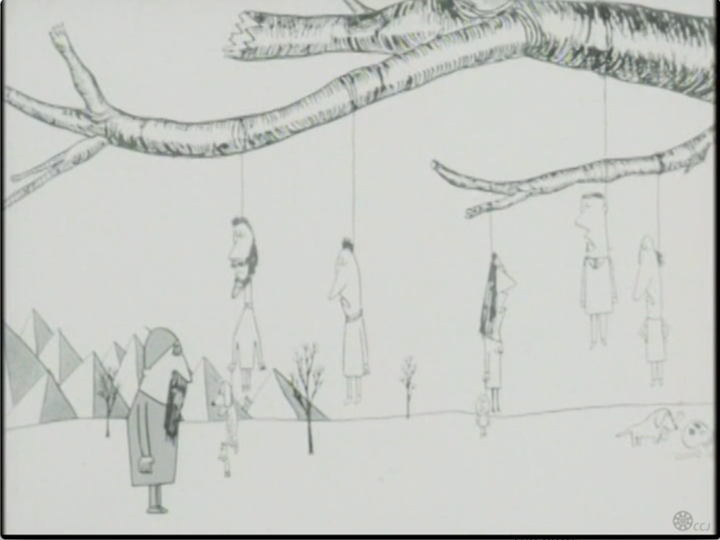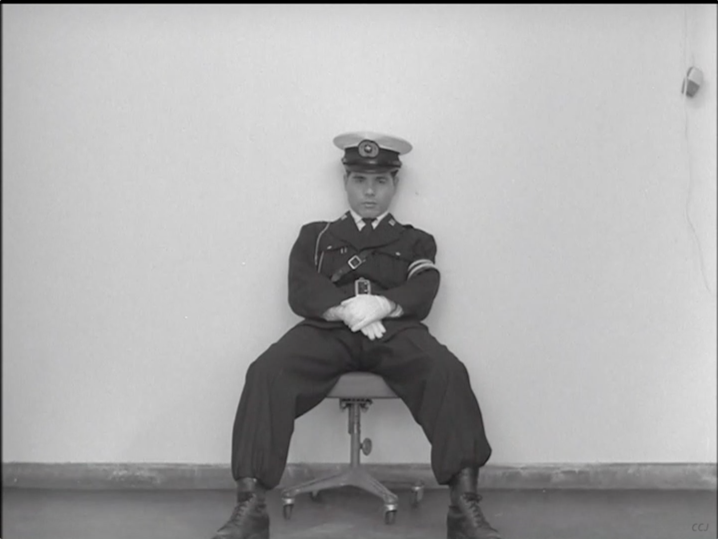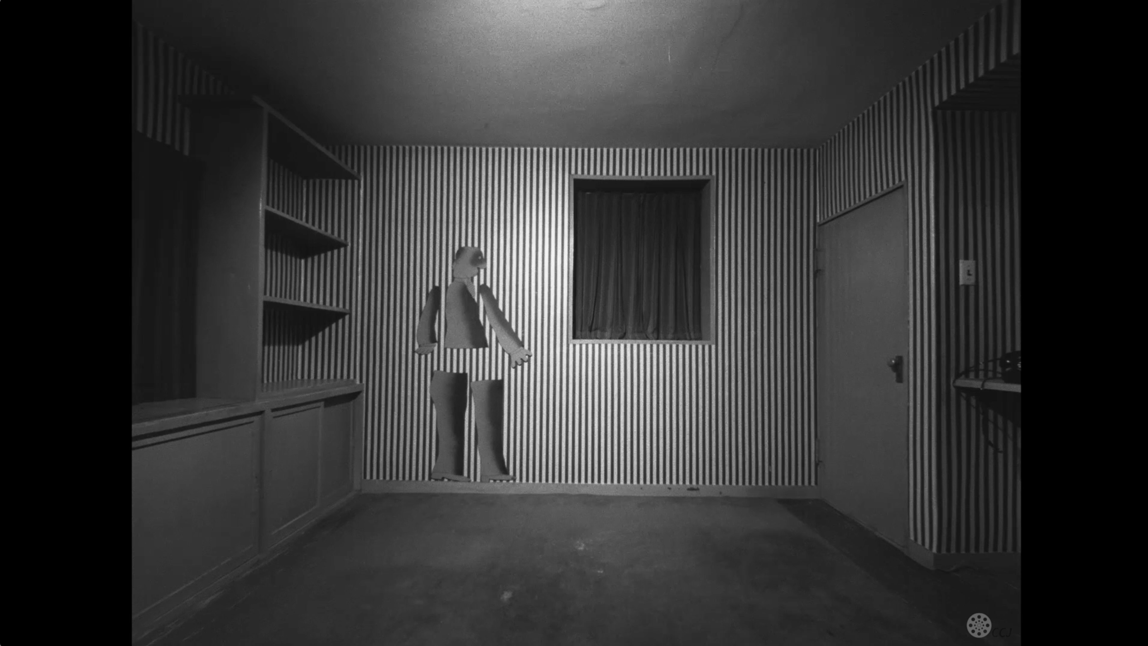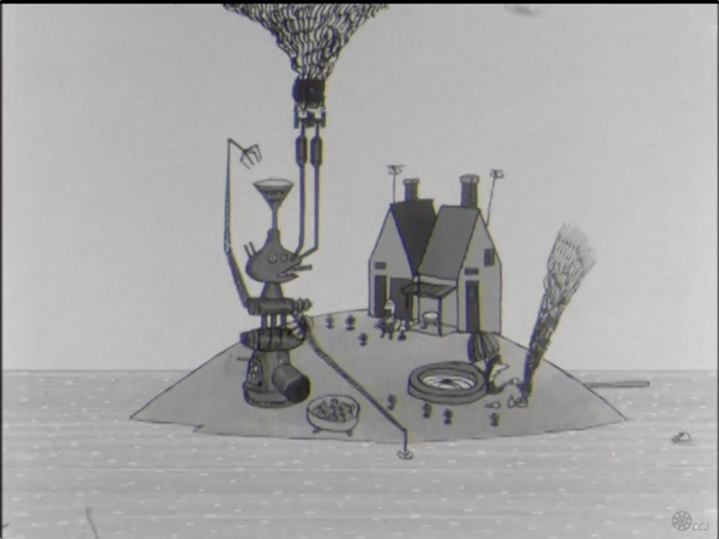CCJ is pleased to present an online screening of works by Yōji Kuri in connection to CCJ’s ongoing focus on experimental animation this year. This program is organized by Fusako Matsu, and is the first in the series of programming that will continue through February 2022 when we will partner with Lightbox Film Center to present in-person screening programs curated by Matsu, Julian Ross, and Go Hirasawa.
PROGRAM
Music for Animation: Yōji Kuri and Kuniharu Akiyama
November 12-21st, 2021
CCJ Streaming Site
https://collaborativecatalogingjapan.muvi.com/en
Two Fishes (B/W Ver.) / 二匹のサンマ(白黒版) | 1960, 22 min, sound, bw
Here and There / あっちはこっち | 1961, 25:12 min, sound, color
The Chair / 椅子 | 1963, 10 min, sound, bw
The Bathroom / ザ・バスルーム | 1972, 10 min, sound, color
The dawn of Japanese avant-garde animation in 1960 was accompanied by sound. This is because the activities of Animation 3-nin no Kai (Three-Person Animation Circle) – the group that used the English loan word “animation” (as distinct from “manga,” which also applies to printed comics) for the first time in Japan, and pioneered short animations by individual creators – were carried out in collaboration with musicians.
The screening of works by Animation 3-nin no Kai (Yōji Kuri, Ryōhei Yanagihara, and Hiroshi Manabe) was organized as part of the Sōgetsu Contemporary Series, which aimed to foster creativity through interaction among diverse artists, and was intended from the start to be multidisciplinary in nature.
There were as yet no artists describing themselves as “animators,” and as set forth in the Animation 3-nin no Kai Manifesto, the group pursued interaction among “painters, cartoonists, designers” and musicians. At the first of a series of screenings titled Three-Person Animation, the musician Kuniharu Akiyama worked with Yōji Kuri on Two Fishes (B / W Ver.), Hikaru Hayashi with Kuri on Fantasia of Stamps (Kitte no Gensō ), Masao Yagi with Ryōhei Yanagihara on Naval Battle, and Hikaru Hayashi with Hiroshi Manabe on Marine Snow. A framework of collaboration with musicians was adopted from the following year onward as well.
Kuniharu Akiyama’s practice is of particular importance in terms of the relationship between animation and sound. In making music for animation, Akiyama considered the unique nature of the medium, and focused on ways in which inorganic objects and materials transform into organic ones and vice versa.* He then applied musique concrète, with a structure analogous to these animated metamorphoses, to the work of Yōji Kuri. This musique concrète, made by modulating sounds whose sources can often be easily imagined, such as birdsong or a cup being set down, was structured in a manner precisely suited the nature of animation, in which things change from one state to another and from figurative to abstract.
Kuri welcomed Akiyama’s ideas, and favored an equal relationship between image and sound, rather than simply adding sound as an expository supplement to the moving image. He took note of differences that emerge when image is produced before sound and vice versa, actively collaborated with experimental musicians such as Tōru Takemitsu, Toshi Ichiyanagi, and Isao Tomita, and produced many short animations employing popular songs of the day, which were featured on the TV program 11PM.
Kuniharu Akiyama created the music for all four works by Yōji Kuri featured in this program. Two Fishes (B/W Ver.) (1960) was screened at Three-Person Animation, and Akiyama himself described this as the first application of musique concrète to animation. A scene on a peaceful island in which the sun plays a bugle was set to music by a jazz ensemble organized by Masao Yagi, which was described by video artist Katsuhiro Yamaguchi as the first jazz-funk made in Japan. Musique concrète fully emerges with the appearance of scientists who bring change to the island. Dozens of frog vocalization patterns and the voices of animals such as chimpanzees are modulated, and the modified sounds are synchronized with Kuri’s animated world in response to changes that occur on the island.
Here and There (1961) fuses live action and animation and was screened at Three-Person Animation 2. Musique concrète and electronic sounds made by modulating everyday noises such as flush toilets are interspersed throughout the work. Contrasts between opposites, as encapsulated by the title – between live-action space and animated space, between mundane sounds of daily life and bizarre noises – and the war between the sexes, a signature theme in Yōji Kuri’s work, are also palpable in the juxtaposition of musique concrète and scat singing.
The Chair (Isu) (1963) is a live-action film screened at Three-Person Animation 3. People ranging from an elementary school girl and a Buddhist monk to famous figures including Tarō Okamoto, Toshi Ichiyanagi, and Shuntarō Tanigawa were asked to spend 15 minutes sitting in (or otherwise engaging with) a chair, and footage shot from a fixed point was compressed with time-lapse photography. Akiyama used the term “bleaching of time” to describe the music for this work in which individuals’ movement patterns over time are revealed, and the soundtrack consists of disjointed fragments of sound given musical texture with instruments such as banjo and contrabass.
The Bathroom (1972) is the last of Kuri’s films on which Akiyama worked. It is a time-lapse animation produced for a solo exhibition at the Sony Building in Ginza, shot when Kuri was moving out of the house where he lived at the time. Akiyama is credited with “recording,” and his work here is remarkable for the surreal effect of applying a distinct sound to each object that appears.
In 1977, Akiyama interviewed Kuri for a series that ran in the film magazine Kinema Junpō, in which they looked back on the relationship between sound and animation centered around Sōgetsu in the 1960s. Their pursuit of the creation of “a new relationship between sound and image” and “a new grammar” remains as innovative as ever. We still have much to learn from Akiyama’s production of sound for animation, and his ideas for musique concrète as a means of applying the unique features of the animation medium to the auditory realm.
Notes and References:
*Here “transformation” refers not to the unfettered metamorphosis of characters as in full animation, but to expansion of the physical imagination via inorganic objects changing into organic objects, as in the Animation 3-nin no Kai works produced largely with cut paper.
On Individually Produced Animation’s Position Between Commerce and Art: Focus on Animation 3-nin no Kai, Toyomi Morishita, 2018.
Central Figures in the History of Japanese Film Music / The Lineage of Animated Films: How the Maestros Made the Sounds of the Movies, by Kuniharu Akiyama, ed. Toshio Takasaki & Fumiaki Asakura, 2021.
Introduction by Fusako Matsu. Translation by Colin Smith.
YŌJI KURI
Yōji Kuri was born in 1928 in Sabae, Fukui, Japan. He has been active in numerous fields including animation, manga, painting, illustration, sculpture, and fiction. He founded the animation studio Kuri Jikken Manga Kobo (Kuri Experimental Animation Studio) in 1960 and began producing works. The same year, Kuri, Ryohei Yanagihara, and Hiroshi Manabe formed Animation 3-nin no Kai (Three-Person Animation Circle) and organized Japan’s first experimental animation screening at Sogetsu Art Center. The screening series was later rebranded as an “Animation Festival,” and became the country’s foundational festival of animation, screening works from both Japan and overseas.
Music by Kuniharu Akiyama, Toshi Ichiyanagi, Yoko Ono, Tōru Takemitsu and others was incorporated into Kuri’s animated films, and many works including his masterpiece Clap Vocalism won awards and were screened at film festivals around the world. In the early days of Japanese television, Kuri produced hundreds of animations for televised series such as 11PM, Minna no Uta (“Songs for Everyone”), and Hyokkori Hyotan Island, and he also appeared in many TV programs and commercials. He continues to paint and create animation today.
http://www.yojikuri.jp/
FUSAKO MATSU
Graduated from Musashino Art University, Moving Image Division, Matsu researches photography and animation. Matsu leads the archives of Yõji Kuri and Taku Furukawa. Matsu has contributed “Animated MV, The Third Golden Age—Michael Patterson’s A-HA’s ‘Take On Me,’ AC part, Powder’s ‘New Tribe’” in ECRIT-O vol. 11. Matsu has co-authored Agnès Varda: Cinéaste of Love and Memory (Documentary Series) (Neoneo Magazine, 2021).
アニメーションのための音楽 クリヨウジと秋山邦晴
松房子
1960年、日本の前衛アニメーションは音とともに始まった。このように言うことができるのは、日本で初めてアニメーションという言葉を使い、個人による短編アニメーション制作がにぎわう嚆矢となった「アニメーション3人の会」の活動が、音楽家による協働を伴っていたためだ。
クリヨウジ、柳原良平、真鍋博による「アニメーション3人の会」の上映は、多様な芸術家たちの交流による創造を目的とした「草月コンテンポラリーシリーズ」の一つとして企画され、多領域の作家が関係し合う共同制作的な性格を予めはらんでいた。
アニメーション作家と名乗る者はまだおらず、「3人の会」のマニフェストにあるように「画家、漫画家、デザイナー」と音楽家が出会うことで、彼らの活動は促進した。「3人のアニメーション」と題した最初の上映会では、クリヨウジの『二匹のサンマ(白黒版)』に秋山邦晴、同じくクリの『切手の幻想』に林光、柳原良平の『海戦』に八木正生、真鍋博『マリーン・スノウ』に林光が協力し、翌年以降の上映作品でも音楽家との共同体制が取られた。
アニメーションと音との関係をめぐり、とりわけ重要なのは秋山邦晴による実践である。秋山はアニメーションの音楽を手がけるにあたって、この領域の固有性を検討し、無機物が有機物へ、有機物が無機物へ変質するという特徴に注目する *。そしてアニメーションの変質性に類似する構造を持つ具体音楽をクリヨウジの作品に適用した。鳥の鳴き声、コップを置く音といった、音の正体が明確に想像できる音を変調させる具体音楽は、ある状態からほかの状態へ、具体から抽象へと変化するアニメーションの性質にまさしく一致する構造を持っていた。
クリもまた秋山による提案を歓迎し、音を映像の補足説明的に使うのではなく、画と音が対等にある関係を好んだ。画先行と音先行の違いに意識をはらい、武満徹や一柳慧、冨田勲といった実験的な音楽家と積極的に協働し、TV番組「11PM」においても当時の歌謡曲を用いたショートアニメーションを数多く制作していった。
今回上映するクリヨウジの4つの作品は、すべて秋山邦晴が音楽を手がけたものだ。『二匹のサンマ(白黒版)』(1960)は「3人のアニメーション」で上映され、具体音楽がアニメーションに初めて登場した作品と秋山自身が述べている。太陽がラッパを吹く穏やかな島のシーンは、八木正生が集結させたジャズメンバーによる編成が重ねられ、日本初のファンキー・ジャズとビデオアーティストの山口勝弘が評している。島に変革をもたらす科学者の登場とともに、本格的に具体音楽が現れる。数十種類の蛙の声帯パターンやチンパンジーといった動物の声が変調され、島自体に起こる変化とも呼応するように、変形した音がクリヨウジのアニメーション世界に同期している。
『あっちはこっち』(1961)は、「3人のアニメーション・2」で上映された実写とアニメーションを組み合わせた作品だ。水洗トイレなどによる生活音を変調させた具体音楽や電子音が全編に散りばめられている。実写空間とアニメーション空間、生活音と異質な音という、タイトルにもなぞらえられる対比とともに、クリヨウジ作品の代名詞といえる男女の抗争関係が、具体音楽とスキャットの交差からも感じられる。
『椅子』(1963)は「3人のアニメーション・3」で上映された実写作品だ。小学生や僧侶のほか、岡本太郎や一柳慧、谷川俊太郎といった著名人が椅子と過ごす15分間が、定点からのコマ落とし撮影によって圧縮されて示される。さまざまな人物像の時間の運動化が個別に呈される本作の音楽を、秋山は「時間の漂白」という言葉を用いて、音楽としてまとめあげられる前の音の断片をバンジョーやコントラバスによって創作している。
『ザ・バスルーム』(1972)は、秋山邦晴が手がけた最後のクリヨウジ作品だ。銀座・ソニービルでの個展に合わせて制作されたコマ撮りアニメーションで、当時クリが住んでいた家を引き払う際に撮影された。秋山は録音としてクレジットされ、出現するオブジェクトに固有の音を当てた異化効果が傑出している。
1977年、秋山邦晴はキネマ旬報の連載を機にクリヨウジにインタビューを行い、二人はそこで草月を舞台に展開した60年代のアニメーションと音との関わりを振り返っている。彼らが目論んだ「音とイメージの新しい関係」「新しい文法」の創造は、未だ古びることがない。秋山邦晴がアニメーションのために制作し、アニメーションという表現が持つ性質を音の領域に置き換えるという具体音楽による提案は、今なお私たちに多くの示唆を与え続けている。
* ここでの変質性はフルアニメーションのキャラクターが自在にフォルムを変化させるメタモルフォーゼではなく、切り絵を中心とする「3人の会」の作品を念頭にした、無機物が有機物へと変わるといった物質的な想像力を広げる機能である。
<参考文献>
「商業と芸術の間にある個人制作アニメーションの場についての考察─ 「アニメーション3人の会」を手がかりに ─」森下豊美著、2018年
『秋山邦晴の日本映画音楽史を形作る人々/アニメーション映画の系譜 マエストロたちはどのように映画の音をつくってきたのか?』秋山邦晴著、高崎俊夫+朝倉史明編、2021年
クリヨウジ(2016年に久里洋二から改名)
1928年福井県鯖江市生まれ。アニメーション、漫画、絵画、イラスト、造形美術、小説などの分野で活動する。1960年に久里実験漫画工房映画部を設立し、アニメーション制作を始める。同年、柳原良平、真鍋博と共に「アニメーション三人の会」を結成し、草月アートセンターで日本初の実験アニメーション上映会を開催。上映会は後に「アニメーション・フェスティバル」と名称を変え、国内外の作品を上映し、日本のアニメーション映画祭の礎となった。
秋山邦晴、一柳慧、オノ・ヨーコ、武満徹らによる音楽をアニメーションに組み入れ、代表作『人間動物園』を始めとする多くの作品が世界中の映画祭で受賞、上映された。また日本のテレビ黎明期においても「11PM」「みんなのうた」「ひょっこりひょうたん島」など数百本のアニメーション作品を制作し、本人もTV番組やCMに多数出演した。現在も絵画、アニメーション制作を続けている。
松房子(まつ・ふさこ)
武蔵野美術大学映像学科卒業。クリヨウジ、古川タクのアニメーション・アーカイブを担当。写真、アニメーションについての研究を行う。『エクリヲ vol.11』に「アニメーテッドMV、第三の黄金時代——マイケル・パターソン『a-ha “Take On Me”』からAC部『Powder “New Tribe”』」を寄稿。共著に『アニエス・ヴァルダ 愛と記憶のシネアスト』(neoneo編集室、2021)。





